Evaluating the Effects of Polyphosphoric Acid (PPA) on the Anti-Ultraviolet Aging Properties of SBR-Modified Asphalt
Abstract
:1. Introduction
2. Materials and Methods
2.1. Materials
2.2. Preparation of Asphalt
- (1)
- Preparation of SBRMA
- (2)
- Preparation of PPA/SBR-MA
2.3. Testing Methods
2.3.1. Ultraviolet (UV) Aging Procedure
2.3.2. Standard Physical Properties Test
2.3.3. Temperature Sweep Test
2.3.4. Bending Beam Rheometer Test (BBR)
2.3.5. Fourier Transform Infrared Spectroscopy (FTIR)
2.3.6. Gel Permeation Chromatography Test (GPC)
3. Results and Discussions
3.1. Standard Physical Properties
3.2. High Temperature Rheological Properties Analysis
3.2.1. Phase Angle
3.2.2. Rutting Factor
3.3. Low Temperature Rheological Properties Analysis
3.4. Chemical Structure Analysis
3.5. Molecular Size Evolution Analyses
3.6. Relationship Analysis of Microcosmic Property and Macroscopical Property
4. Conclusions
- (1)
- The penetration of asphalt decreases with the addition of PPA, which proves that PPA/SBR-MA becomes harder and more resistant to deformation. The increase in the softening point indicates a higher temperature stability of asphalt. The incorporation of PPA significantly reduces the influence of UV aging on the consistency, high temperature stability, and low temperature flexibility of SBRMA according to the aging indexes of the penetration, softening point, and ductility.
- (2)
- The addition of PPA significantly improves the high temperature deformation resistance of SBRMA before UV aging according to the analysis of the phase angle δ and rutting factor . The high temperature performance of the three asphalts is improved after UV aging. However, the rutting factor aging index (RAI) of 90#A, SBRMA, and PPA/SBR-MA are 1.83, 1.65, and 1.49, respectively, indicating that PPA can reduce the sensitivity of the high temperature rheological parameters of SBRMA to UV light.
- (3)
- Based on the variations of S(60) and m before and after UV aging, it is found that UV aging will crack the low temperature properties of asphalt according to the change rule of these values. However, PPA/SBR-MA has the best flexibility and stress relaxation ability, which implies that PPA enhances the low temperature cracking resistance of SBRMA. The low temperature aging indexes Iλ of 90#A, SBRMA, and PPA/SBR-MA are 0.32, 0.52, and 0.65 at −12 °C temperature, and 0.51, 0.75, and 0.81 at −18 °C, respectively, which indicates that PPA can significantly reduce the UV aging sensitivity of SBRMA.
- (4)
- The FTIR and GPC tests show that the addition of PPA gives the SBRMA a more stable dispersion system. UV aging mainly leads to the oxygen absorption of the saturated carbon chain and the degradation of the SBR modifier, along with the evaporation of small molecules. PPA can significantly enhance the anti-UV aging property of SBRMA because it mainly inhibits the degradation of the SBR modifier and delays the aging process of base asphalt.
- (5)
- The microscopic aging indexes ILMS and IMw after UV aging are significantly correlated with the macroscopic aging indexes RP, SPI, DR, RAI, and Iλ by the analysis of the Pearson correlation coefficient. They can be used as the main evaluation indexes of the microscopic aging effect. The ICO and IMn have a good correlation with the macro performance aging index. However, ISMS is unsuitable for evaluating the aging effect and is only applicable to the mechanism explanation of the aging process. Microscopic experiments can not only explain the microscopic mechanism of action, but can also predict the macroscopic properties.
Author Contributions
Funding
Institutional Review Board Statement
Informed Consent Statement
Data Availability Statement
Conflicts of Interest
References
- Yu, H.; Bai, X.; Qian, G.; Wei, H.; Gong, X.; Jin, J.; Li, Z. Impact of Ultraviolet Radiation on the Aging Properties of SBS-Modified Asphalt Binders. Polymers 2019, 11, 1111. [Google Scholar] [CrossRef] [Green Version]
- Chen, Z.; Zhang, H.; Duan, H. Investigation of ultraviolet radiation aging gradient in asphalt binder. Constr. Build. Mater. 2020, 246, 118501. [Google Scholar] [CrossRef]
- Zhang, H.; Yu, J.; Feng, Z.; Xue, L.; Wu, S.P. Effect of aging on the morphology of bitumen by atomic force microscopy. J. Microsc. 2012, 246, 11–19. [Google Scholar] [CrossRef] [PubMed]
- Cheraghian, G.; Wistuba, M.P. Effect of Fumed silica nanoparticles on ultraviolet aging resistance of bitumen. Nanomaterials 2021, 11, 454. [Google Scholar] [CrossRef]
- Jing, R.; Varveri, A.; Liu, X.; Scarpas, A.; Erkens, S. Ageing effect on chemo-mechanics of bitumen. Road Mater. Pavement Des. 2021, 22, 1044–1059. [Google Scholar] [CrossRef] [Green Version]
- Eberhardsteiner, L.; Füssl, J.; Hofko, B.; Handle, F.; Hospodka, M.; Blab, R.; Grothe, H. Towards a microstructural model of bitumen ageing behaviour. Int. J. Pavement Eng. 2015, 16, 939–949. [Google Scholar] [CrossRef]
- Ferrotti, G.; Baaj, H.; Besamusca, J.; Bocci, M.; Cannone-Falchetto, A.; Grenfell, J.; Hofko, B.; Porot, L.; Poulikakos, L.; You, Z.J.M.; et al. Comparison between bitumen aged in laboratory and recovered from HMA and WMA lab mixtures. Mater. Struct. 2018, 51, 150. [Google Scholar] [CrossRef]
- Zhang, C.; Yu, J.; Xu, S.; Xue, L.; Cao, Z.J.C. Influence of UV aging on the rheological properties of bitumen modified with surface organic layered double hydroxides. Constr. Build. Mater. 2016, 123, 574–580. [Google Scholar] [CrossRef]
- Wei, H.; Zhang, H.; Li, J.; Zheng, J.; Ren, J. Effect of loading rate on failure characteristics of asphalt mixtures using acoustic emission technique. Constr. Build. Mater. 2023, 364, 129835. [Google Scholar] [CrossRef]
- Zhang, S.Y.; Cui, Y.A.; Wei, W.W. Low-temperature characteristics and microstructure of asphalt under complex aging conditions. Constr. Build. Mater. 2021, 303, 124408. [Google Scholar] [CrossRef]
- Yildirim, Y. Polymer modified asphalt binders. Constr. Build. Mater. 2007, 21, 66–72. [Google Scholar] [CrossRef]
- Yu, J.-Y.; Zhang, H.-L.; Sun, P.; Zhao, S.-F. Laboratory performances of nano-particles/polymer modified asphalt mixtures developed for the region with hot summer and cold winter and field evaluation. Road Mater. Pavement Des. 2020, 21, 1529–1544. [Google Scholar] [CrossRef]
- Li, Q.S.; Zhang, H.L.; Chen, Z.H. Improvement of short-term aging resistance of styrene-butadiene rubber modified asphalt by Sasobit and epoxidized soybean oil. Constr. Build. Mater. 2021, 271, 121870. [Google Scholar] [CrossRef]
- Liao, M.J.; Liu, Z.H.; Gao, Y.L.; Liu, L.; Xiang, S.C. Study on UV aging resistance of nano-TiO2/montmorillonite/styrene-butadiene rubber composite modified asphalt based on rheological and microscopic properties. Constr. Build. Mater. 2021, 301, 124108. [Google Scholar] [CrossRef]
- Babagoli, R.; Jalali, F.; Khabooshani, M. Performance properties of WMA modified binders and asphalt mixtures containing PPA/SBR polymer blends. J. Thermoplast. Compos. Mater. 2021, 36, 274–306. [Google Scholar] [CrossRef]
- Zhang, F.; Hu, C.B. The research for SBS and SBR compound modified asphalts with polyphosphoric acid and sulfur. Constr. Build. Mater. 2013, 43, 461–468. [Google Scholar] [CrossRef]
- Zhang, F.; Yu, J.Y. The research for high-performance SBR compound modified asphalt. Constr. Build. Mater. 2010, 24, 410–418. [Google Scholar] [CrossRef]
- Domingos, M.D.I.; Faxina, A.L. High-temperature properties and modeling of asphalt binders modified with sbr copolymer and ppa in the multiple stress creep and recovery (MSCR) test. Appl. Rheol. 2016, 26, 53830. [Google Scholar]
- Liang, P.; Liang, M.; Fan, W.Y.; Zhang, Y.Z.; Qian, C.D.; Ren, S.S. Improving thermo-rheological behavior and compatibility of SBR modified asphalt by addition of polyphosphoric acid (PPA). Constr. Build. Mater. 2017, 139, 183–192. [Google Scholar] [CrossRef]
- Gao, L.N.; Cai, N.N.; Fu, X.H.; He, R.; Zhang, H.G.; Zhou, J.Y.; Kuang, D.L.; Liu, S.W. Influence of PPA on the Short-Term Antiaging Performance of Asphalt. Adv. Civ. Eng. 2021, 2021, 6628778. [Google Scholar] [CrossRef]
- Zhang, F.; Hu, C.B. Influence of aging on thermal behavior and characterization of SBR compound-modified asphalt. J. Therm. Anal. Calorim. 2014, 115, 1211–1218. [Google Scholar] [CrossRef]
- Han, D.Q.; Hu, G.S.; Zhang, J.T. Study on Anti-Aging Performance Enhancement of Polymer Modified Asphalt with High Linear SBS Content. Polymers 2023, 15, 256. [Google Scholar] [CrossRef]
- Ge, D.D.; Yan, K.Z.; You, L.Y.; Wang, Z.X. Modification mechanism of asphalt modified with Sasobit and Polyphosphoric acid (PPA). Constr. Build. Mater. 2017, 143, 419–428. [Google Scholar] [CrossRef]
- Wei, J.G.; Shi, S.; Zhou, Y.M.; Chen, Z.Y.; Yu, F.; Peng, Z.Y.; Duan, X.R. Research on Performance of SBS-PPA and SBR-PPA Compound Modified Asphalts. Materials 2022, 15, 2112. [Google Scholar] [CrossRef]
- Liu, S.J.; Zhou, S.B.; Peng, A.H. Evaluation of polyphosphoric acid on the performance of polymer modified asphalt binders. J. Appl. Polym. Sci. 2020, 137, 48984. [Google Scholar] [CrossRef]
- Hao, P.W.; Zhai, R.X.; Zhang, Z.X.; Cao, X.J. Investigation on performance of polyphosphoric acid (PPA)/SBR compound-modified asphalt mixture at high and low temperatures. Road Mater. Pavement Des. 2019, 20, 1376–1390. [Google Scholar] [CrossRef]
- Chen, P.F.; Zhang, Z.M.; Li, Y.M. Anti-ultraviolet aging properties of polyphosphoric acid/styrene-butadiene rubber composite modified asphalts. China Synth. Rubber Ind. 2020, 43, 60–65. [Google Scholar]
- Jafari, M.; Babazadeh, A. Evaluation of polyphosphoric acid-modified binders using multiple stress creep and recovery and linear amplitude sweep tests. Road Mater. Pavement Des. 2016, 17, 859–876. [Google Scholar] [CrossRef]
- Wang, J.N. Study on Aging Mechanism and Pheologic Behavior of Asphalt under Simulate Ultraviolet; Harbin Institute of Technology: Harbin, China, 2008. [Google Scholar]
- JTG E20-2011; Standard Test Methods of Bitumen and Bituminous Mixture for Highway Engineering. China Communications Press: Beijing, China, 2011.
- Geng, J.; Meng, H.; Xia, C.; Chen, M.; Lu, T.; Zhou, H. Effect of dry-wet cycle aging on physical properties and chemical composition of SBS-modified asphalt binder. Mater. Struct. 2021, 54, 120. [Google Scholar] [CrossRef]
- Geng, J.; Chen, M.; Xia, C.; Liao, X.; Chen, Z.; Chen, H. Aging characteristics of crumb rubber modified asphalt binder and mixture with regenerating agent. Constr. Build. Mater. 2021, 299, 124299. [Google Scholar] [CrossRef]
- ASTM-D7175; Standard Test Method for Determining the Rheological Properties of Asphalt Binder. Using a Dynamic Shear Rheometer. ASTM: West Conshohocken, PA, USA, 2015.
- Camargo, I.G.D.; Ben Dhia, T.; Loulizi, A.; Hofko, B.; Mirwald, J. Anti-aging additives: Proposed evaluation process based on literature review. Road Mater. Pavement Des. 2021, 22, S134–S153. [Google Scholar] [CrossRef]
- ASTM-D6648; Standard Test Method for Determining the Flexural Creep Stiffness of Asphalt Binder Using the Bending Beam Rheometer (BBR). ASTM: West Conshohocken, PA, USA, 2001.
- Li, J.; Xiao, F.; Amirkhanian, S.N. Storage, fatigue and low temperature characteristics of plasma treated rubberized binders. Constr. Build. Mater. 2019, 209, 454–462. [Google Scholar] [CrossRef]
- Xu, N.; Wang, H.N.; Chen, Y.; Miljkovic, M.; Feng, P.N.; Ding, H.Y. Thermal storage stability and rheological properties of multi-component styrene-butadiene-styrene composite modified bitumen. Constr. Build. Mater. 2022, 322, 126494. [Google Scholar] [CrossRef]
- Hung, A.M.; Fini, E.H. Absorption spectroscopy to determine the extent and mechanisms of aging in bitumen and asphaltenes. Fuel 2019, 242, 408–415. [Google Scholar] [CrossRef]
- Hou, X.D.; Lv, S.T.; Chen, Z.; Xiao, F.P. Applications of Fourier transform infrared spectroscopy technologies on asphalt materials. Measurement 2018, 121, 304–316. [Google Scholar] [CrossRef]
- Poulikakos, L.; Wang, D.; Porot, L.; Hofko, B. Impact of asphalt aging temperature on chemo-mechanics. RSC Adv. 2019, 9, 11602–11613. [Google Scholar]
- Li, C.; Xie, X.F.; Wang, L.; Guo, Y.Y.; Zhang, L.; Xue, Z.H. Evaluation of the effect of thermal oxygen aging on base and SBS-modified bitumen at micro and macroscales. Constr. Build. Mater. 2022, 324, 126623. [Google Scholar] [CrossRef]
- Hosseinnezhad, S.; Zadshir, M.; Yu, X.; Yin, H.; Sharma, B.K.; Fini, E. Differential effects of ultraviolet radiation and oxidative aging on bio-modified binders. Fuel 2019, 251, 45–56. [Google Scholar] [CrossRef]
- Kim, K.W.; Burati Jr, J.L.; Park, J.S. Methodology for defining LMS portion in asphalt chromatogram. J. Mater. Civ. Eng. 1995, 7, 31–40. [Google Scholar] [CrossRef]
- Wang, Z.; Xu, X.; Wang, X.; Jinyang, H.; Guo, H.; Yang, B. Performance of modified asphalt of rubber powder through tetraethyl orthosilicate (TEOS). Constr. Build. Mater. 2021, 267, 121032. [Google Scholar] [CrossRef]
- Liu, J.; Qi, L.; Wang, X.; Li, M.; Wang, Z. Influence of aging induced by mutation in temperature on property and microstructure development of asphalt binders. Constr. Build. Mater. 2022, 319, 126083. [Google Scholar] [CrossRef]
- Li, Z.Z.; Liu, H.J.; Chen, W.X.; Li, Y.; Zhao, Z.P.; Yin, Y.P.; Li, M.Y. Influence of residual SB di-block in SBS on the thermo-oxidative aging behaviors of SBS and SBS modified asphalt. Mater. Struct. 2022, 55, 23. [Google Scholar] [CrossRef]
- Cheng, P.; Li, Y.; Zhang, Z.J. Effect of phenolic resin on the rheological, chemical, and aging properties of SBR-modified asphalt. Int. J. Pavement Res. Technol. 2021, 14, 421–427. [Google Scholar] [CrossRef]
- Liu, H.; Zhang, M.; Wang, Y.; Chen, Z.; Hao, L. Rheological properties and modification mechanism of polyphosphoric acid-modified asphalt. Road Mater. Pavement Des. 2020, 21, 1078–1095. [Google Scholar] [CrossRef]
- Wang, F.; Huang, T.; Xin, G.; Mu, M.; Shen, Q.J. Study on Conventional and Rheological Properties of Corn Stalk Bioasphalt/PPA Composite Modified Asphalt. Adv. Civ. Eng. 2021, 2021, 7928189. [Google Scholar] [CrossRef]
- Qian, C.; Fan, W.; Ren, F.; Lv, X.; Xing, B. Influence of polyphosphoric acid (PPA) on properties of crumb rubber (CR) modified asphalt. Constr. Build. Mater. 2019, 227, 117094. [Google Scholar] [CrossRef]
- Masson, J.; Gagné, M.; Robertson, G.; Collins, P. Reactions of polyphosphoric acid and bitumen model compounds with oxygenated functional groups: Where is the phosphorylation? Energy Fuels 2008, 22, 4151–4157. [Google Scholar] [CrossRef] [Green Version]
- Hung, A.; Fini, E.H. Surface morphology and chemical mapping of UV-aged thin films of bitumen. Sustain. Chem. Eng. 2020, 8, 11764–11771. [Google Scholar] [CrossRef]
- Lin, P.; Huang, W.D.; Tang, N.P.; Xiao, F.P.; Li, Y. Understanding the low temperature properties of Terminal Blend hybrid asphalt through chemical and thermal analysis methods. Constr. Build. Mater. 2018, 169, 543–552. [Google Scholar] [CrossRef]
- Orange, G.; Dupuis, D.; Martin, J.; Farcas, F.; Such, C.; Marcant, B. Chemical modification of bitumen through polyphosphoric acid: Properties-micro-structure relationship. In Proceedings of the 3rd Eurasphalt and Eurobitume Congress, Vienna, Austria, 12–14 May 2004. [Google Scholar]
- Zaidullin, I.; Petrova, L.; Yakubov, M.; Borisov, D.N. Variation of the composition of asphaltenes in the course of bitumen aging in the presence of antioxidants. Russ. J. Appl. Chem. 2013, 86, 1070–1075. [Google Scholar] [CrossRef]
- Li, Y.; Feng, J.; Wu, S.; Chen, A.; Kuang, D.; Gao, Y.; Zhang, J.; Li, L.; Wan, L.; Liu, Q. Review of ultraviolet ageing mechanisms and anti-ageing methods for asphalt binders. J. Road Eng. 2022, 2, 137–155. [Google Scholar] [CrossRef]
- Zhou, Y.; Chen, J.; Zhang, K.; Guan, Q.; Guo, H.; Xu, P.; Wang, J. Study on aging performance of modified asphalt binders based on characteristic peaks and molecular weights. Constr. Build. Mater. 2019, 225, 1077–1085. [Google Scholar] [CrossRef]
- Baek, S.H.; Kim, H.H.; Doh, Y.S.; Kim, K.W. Estimation of high-temperature properties of rubberized asphalt using chromatograph. KSCE J. Civ. Eng. 2009, 13, 161–167. [Google Scholar] [CrossRef]

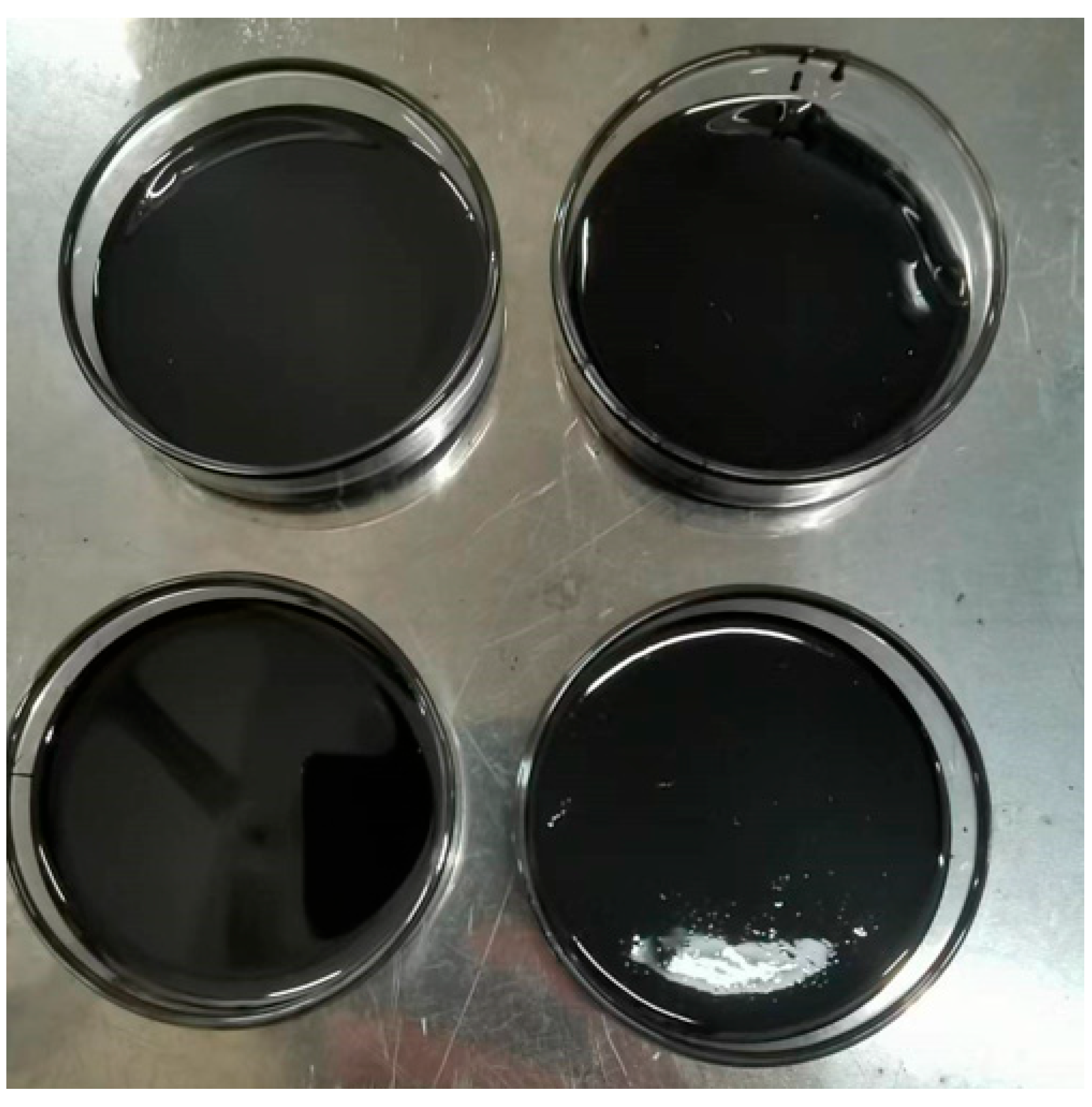
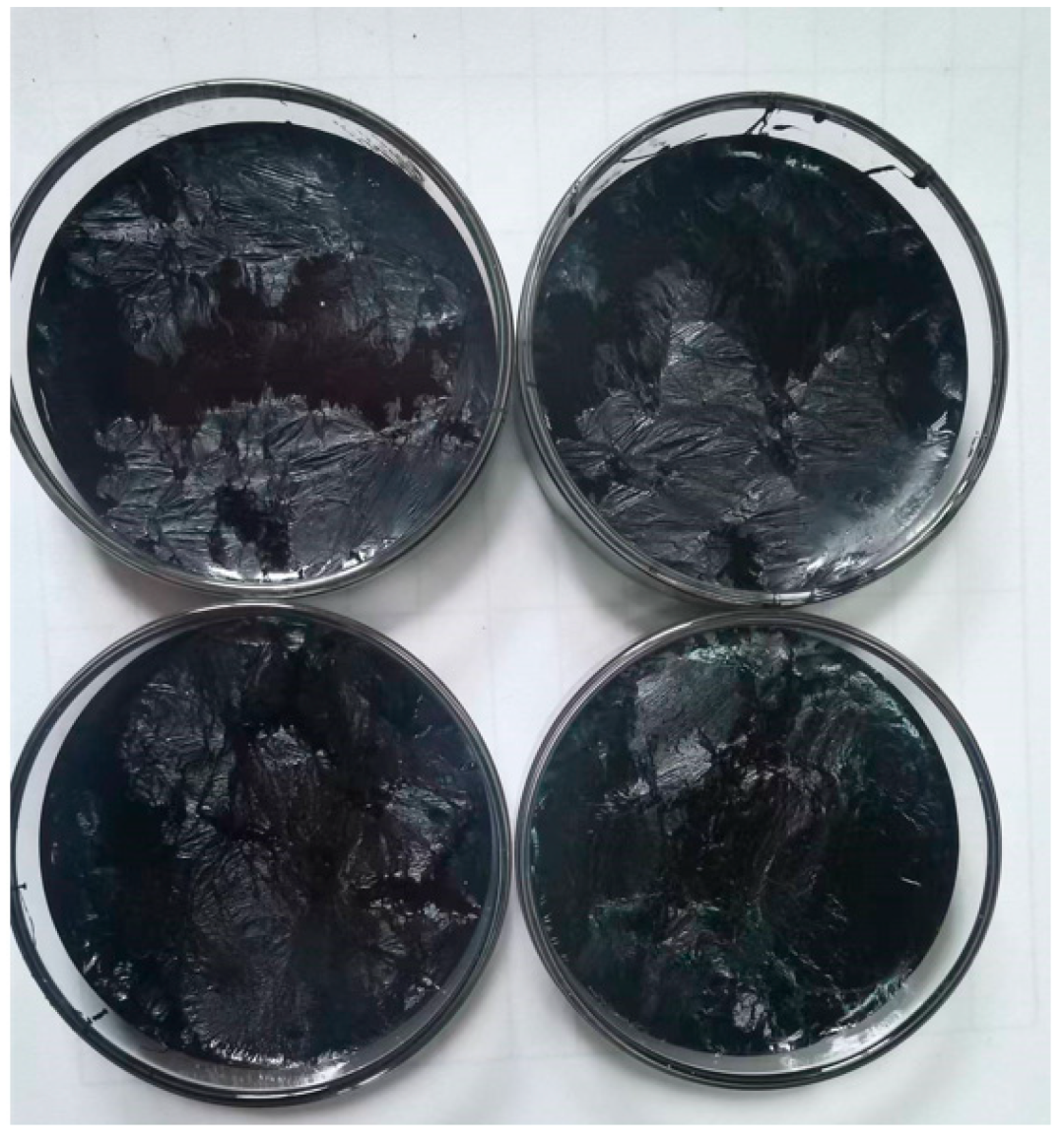
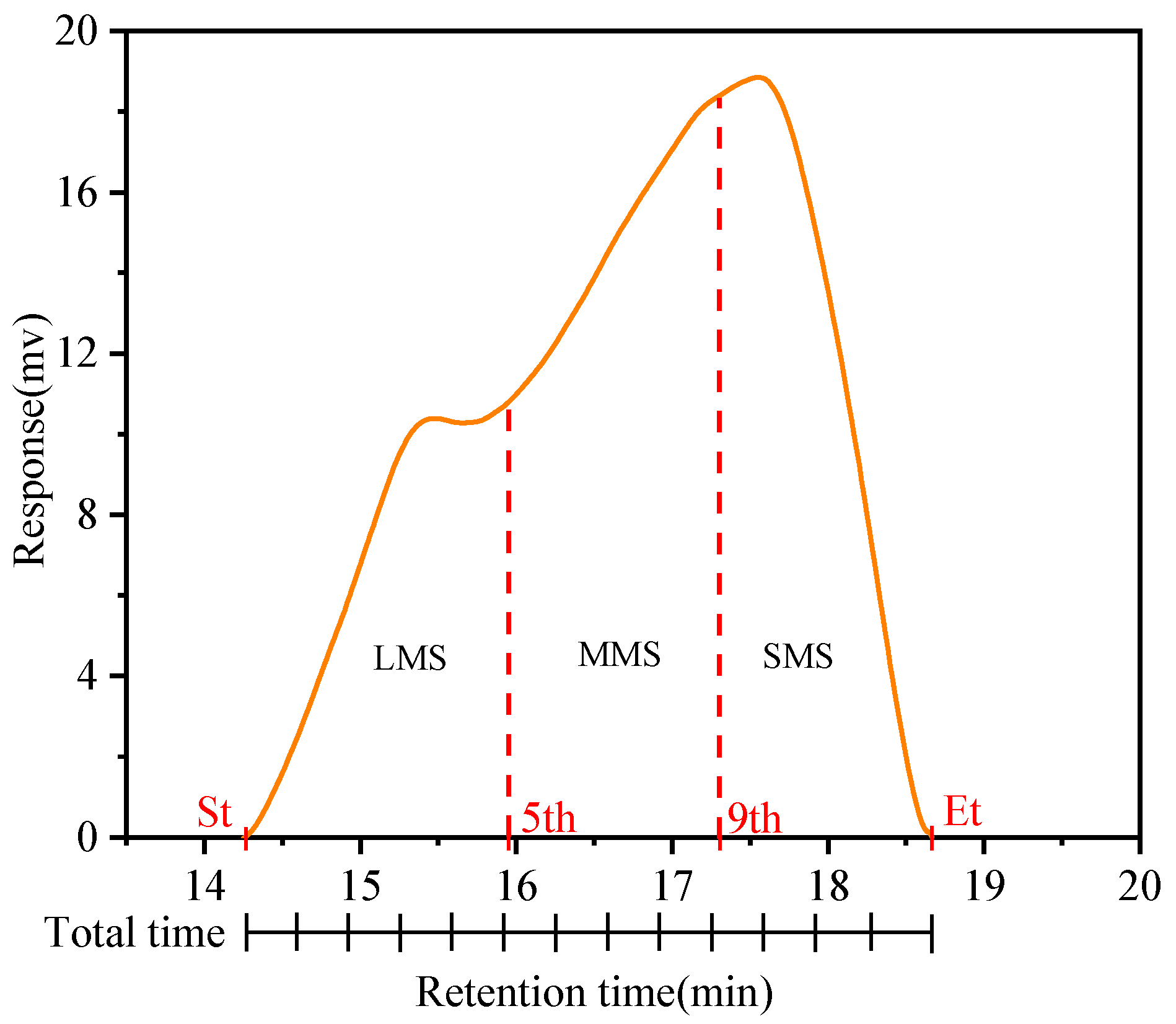


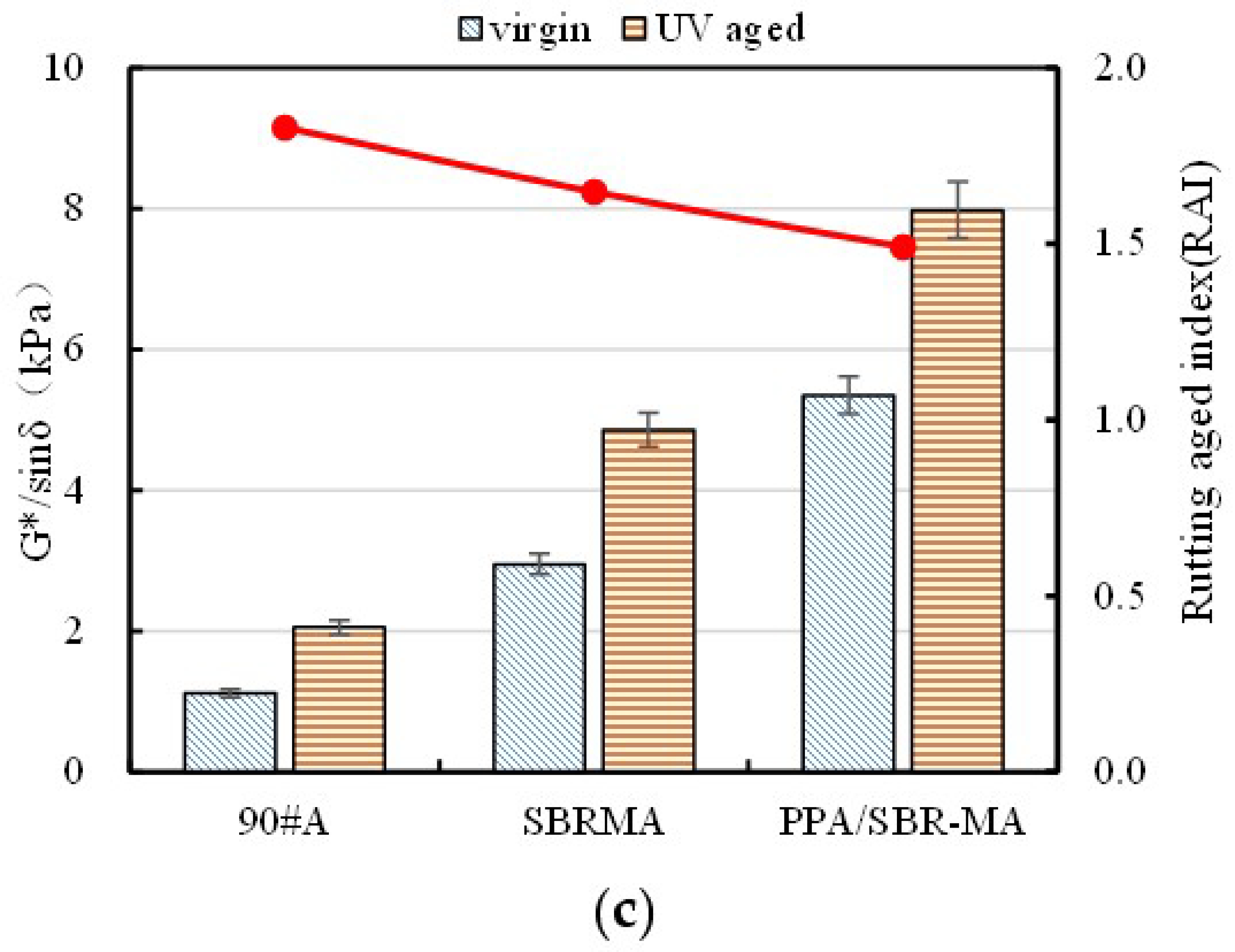

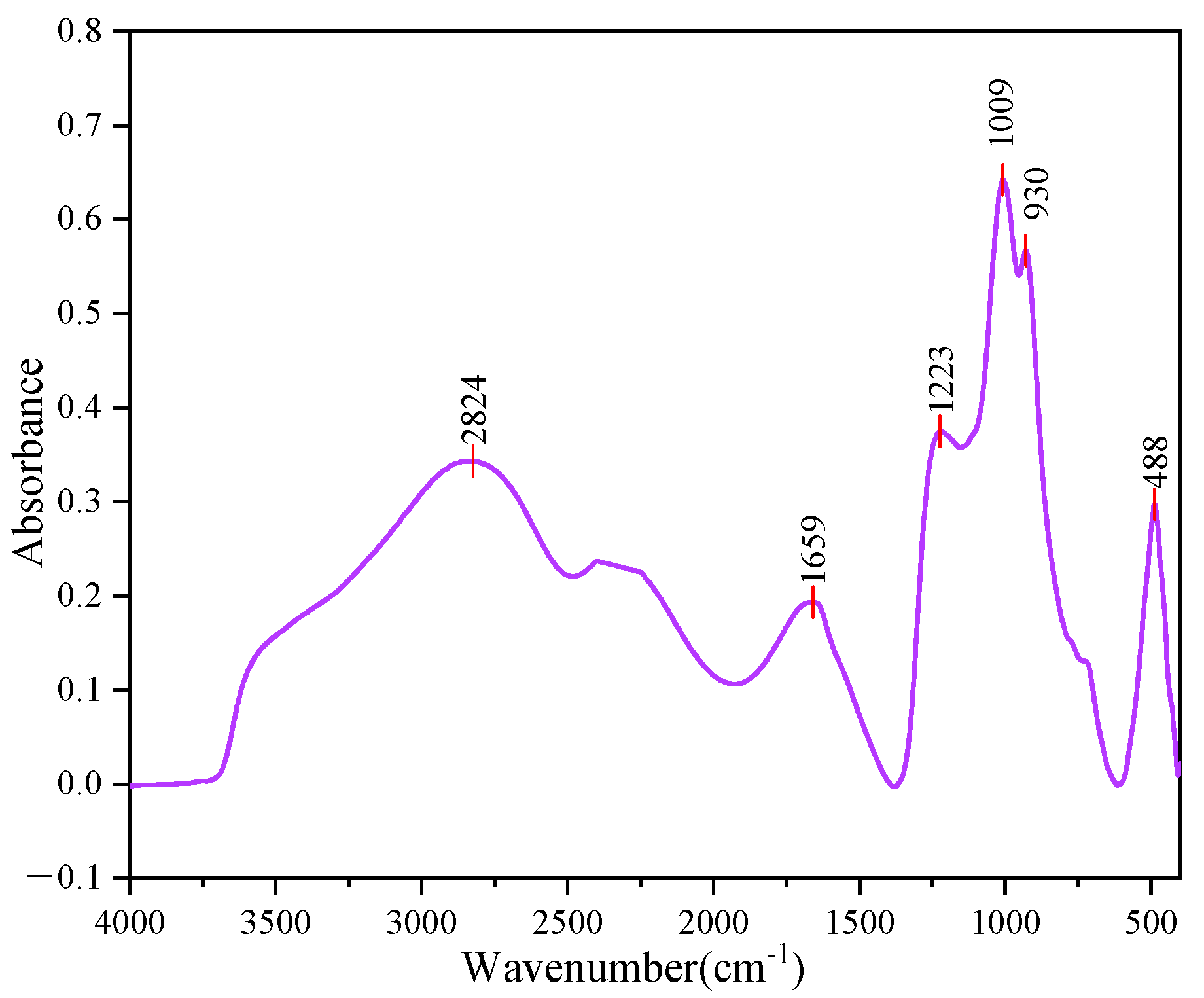
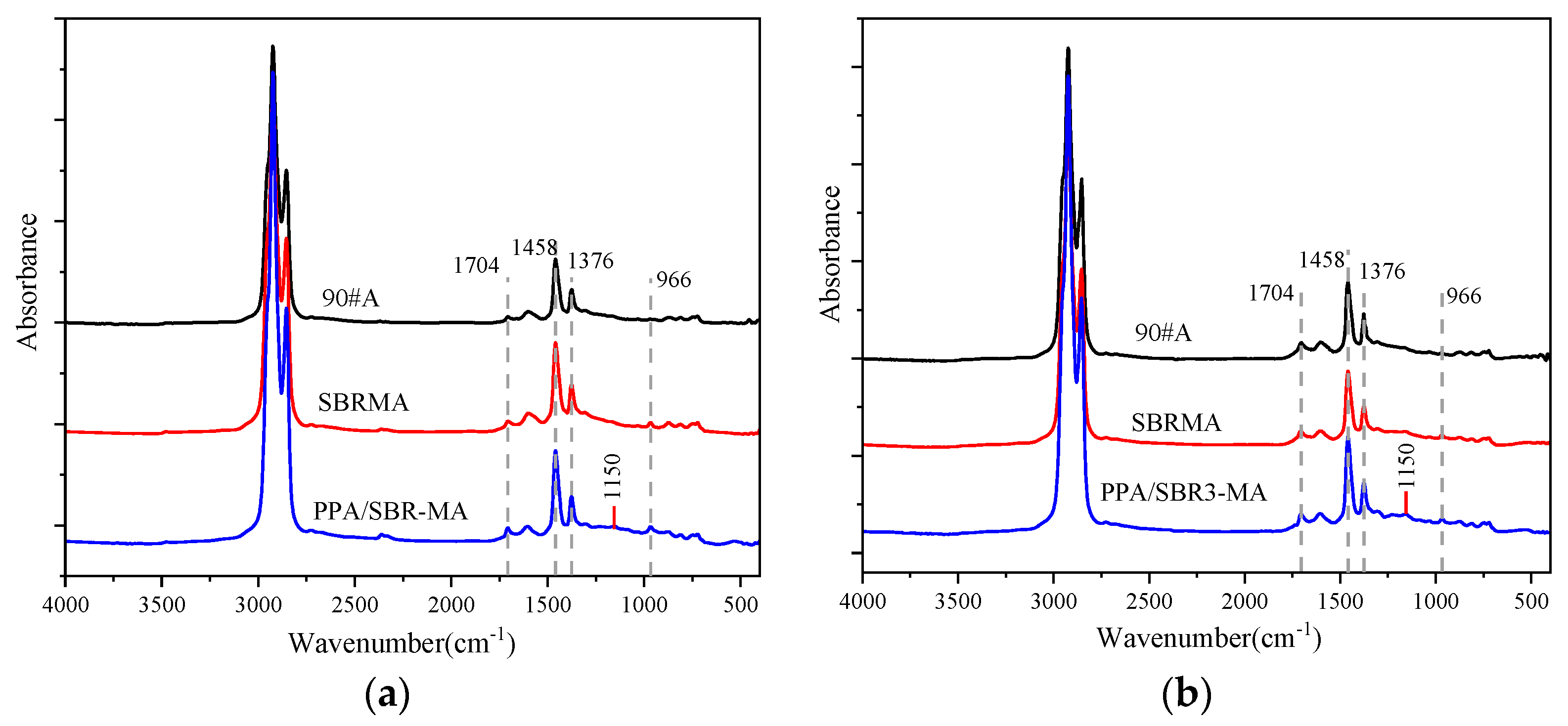

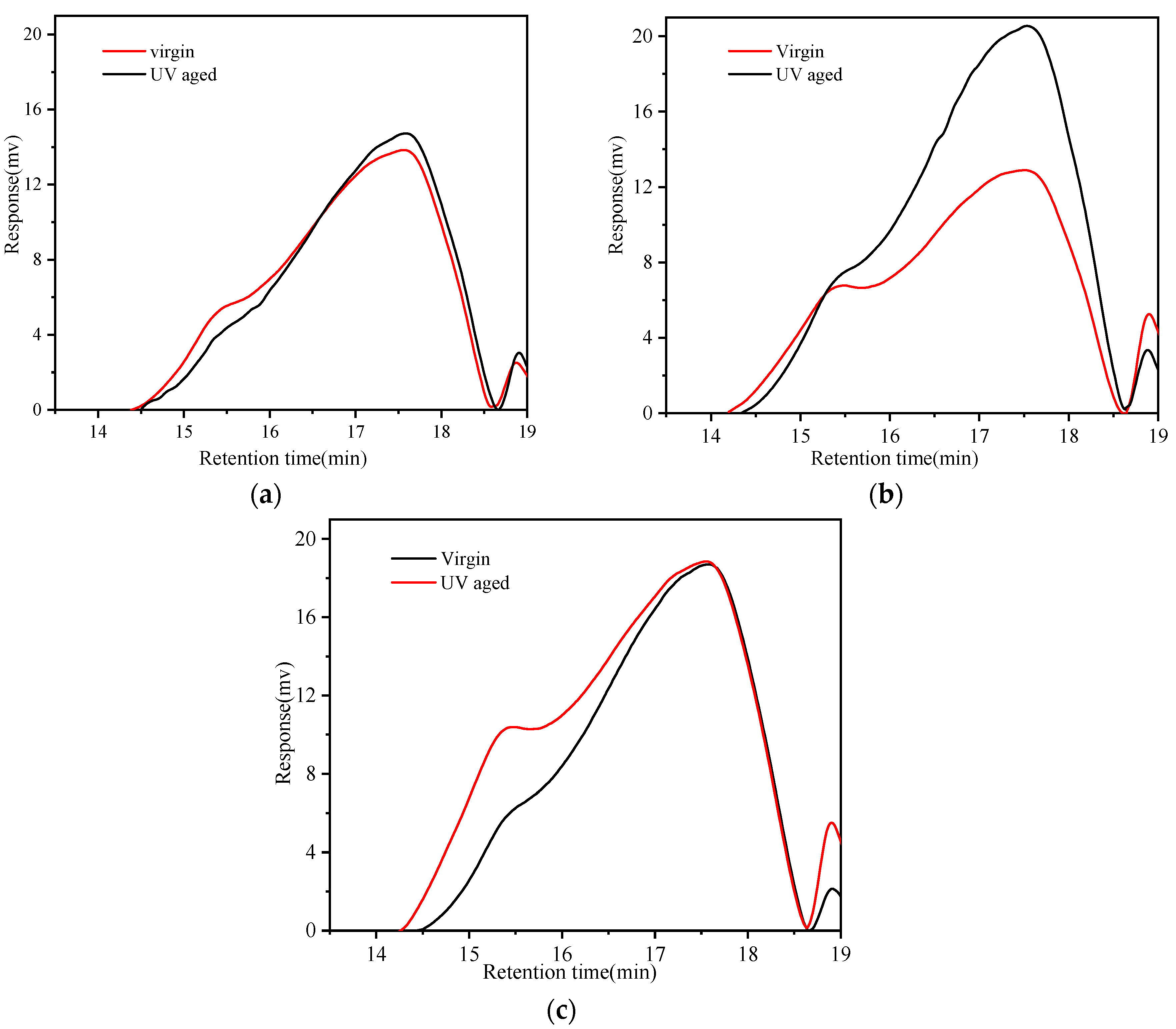
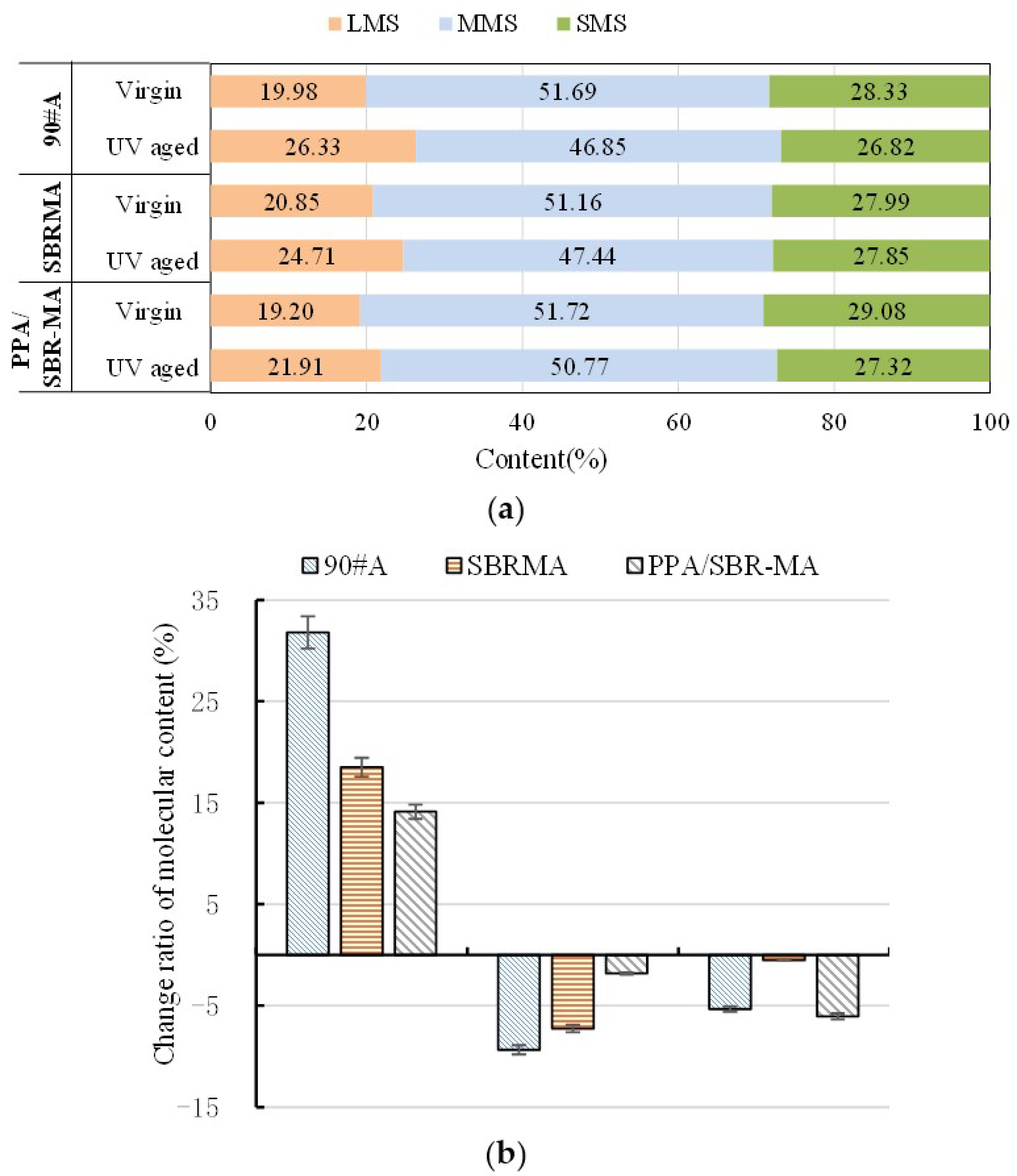
| Parameter | Results |
|---|---|
| Penetration (25 °C, 0.1 mm) | 88.1 |
| Softening point (°C) | 45.4 |
| Ductility (15 °C, cm) | >150 |
| C (%) | 87.02 |
| H (%) | 9.31 |
| O (%) | 3.12 |
| N (%) | 0.51 |
| S (%) | 0 |
| Parameter | Results |
|---|---|
| Granularity (16-mesh, %) | 98.6 |
| Bound styrene content (%) | 23.0 |
| Mooney viscosity (ML) | 55.5 |
| Tensile strength (MPa) | 25.0 |
| Breaking elongation (%) | 378 |
| 300% Constant tensile stress (MPa) | 15.0 |
| Parameter | Results |
|---|---|
| Phosphoric acid (H3PO4, %) | 115.2 |
| Phosphorus pentoxide (P2O5, %) | 83.5 |
| Chloride (Cl, %) | <0.0003 |
| Fe (%) | 0.0014 |
| As (%) | 0.009 |
| Heavy metal (Pb, %) | <0.002 |
| Sample | Index | ||||
|---|---|---|---|---|---|
| Mn | Mw | d | IMn (%) | IMw (%) | |
| 90#-virgin | 909 | 3634 | 3.998 | 23.65 | 43.51 |
| 90#-UV aged | 1124 | 5215 | 4.640 | ||
| SBR-virgin | 998 | 3996 | 4.004 | −4.81 | 24.27 |
| SBR-UV aged | 950 | 4966 | 5.227 | ||
| PPA/SBR-virgin | 905 | 3460 | 3.823 | −1.77 | 12.86 |
| PPA/SBR-UV aged | 889 | 3905 | 4.393 | ||
| Macro-Aging Index | Micro-Aging Index | |||||
|---|---|---|---|---|---|---|
| ILMS | IMMS | ISMS | IMn | IMw | CRICO | |
| RP | −0.9412 | 0.9823 | −0.1848 | −0.7754 | −0.9783 | −0.9870 |
| SPI | −0.9505 | 0.9765 | −0.1568 | −0.7931 | −0.9838 | −0.9821 |
| DR | −0.9949 | 0.8052 | 0.2573 | −0.9720 | −0.9719 | −0.8212 |
| RAI | 0.9694 | −0.9597 | 0.0894 | 0.8326 | 0.9937 | 0.9670 |
| Iλ (−12 °C) | −0.9875 | 0.9307 | 7.05 × 10−5 | −0.8788 | −0.9997 | −0.9403 |
| Iλ (−18 °C) | −0.9979 | 0.8261 | 0.2222 | −0.9629 | −0.9798 | −0.8413 |
Disclaimer/Publisher’s Note: The statements, opinions and data contained in all publications are solely those of the individual author(s) and contributor(s) and not of MDPI and/or the editor(s). MDPI and/or the editor(s) disclaim responsibility for any injury to people or property resulting from any ideas, methods, instructions or products referred to in the content. |
© 2023 by the authors. Licensee MDPI, Basel, Switzerland. This article is an open access article distributed under the terms and conditions of the Creative Commons Attribution (CC BY) license (https://creativecommons.org/licenses/by/4.0/).
Share and Cite
Xu, Y.; Niu, K.; Zhu, H.; Chen, R.; Ou, L. Evaluating the Effects of Polyphosphoric Acid (PPA) on the Anti-Ultraviolet Aging Properties of SBR-Modified Asphalt. Materials 2023, 16, 2784. https://doi.org/10.3390/ma16072784
Xu Y, Niu K, Zhu H, Chen R, Ou L. Evaluating the Effects of Polyphosphoric Acid (PPA) on the Anti-Ultraviolet Aging Properties of SBR-Modified Asphalt. Materials. 2023; 16(7):2784. https://doi.org/10.3390/ma16072784
Chicago/Turabian StyleXu, Yanling, Kaimin Niu, Hongzhou Zhu, Ruipu Chen, and Li Ou. 2023. "Evaluating the Effects of Polyphosphoric Acid (PPA) on the Anti-Ultraviolet Aging Properties of SBR-Modified Asphalt" Materials 16, no. 7: 2784. https://doi.org/10.3390/ma16072784





